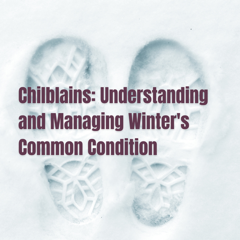Chilblains: Understanding and Managing Winter’s Common Condition

As winter sets in, many people experience chilblains, a common and uncomfortable condition caused by exposure to cold, damp conditions. At Dulwich Podiatry, we’re here to help you understand and manage this seasonal issue to keep your feet healthy and pain-free.
What Are Chilblains?
Also known as perniosis, chilblains occur when skin is exposed to cold temperatures, leading to a localised inflammatory response. This condition affects around 1 in 10 people in the UK and typically appears 12–24 hours after exposure to cold. Chilblains manifest as painful, swollen, red, purple, or blue patches or nodules, often found on toes, fingers, ears, and the nose. Occasionally, they can also appear on the face or legs.
What Causes Chilblains?
The main cause is prolonged exposure to cold temperatures above freezing. Initially, affected areas turn pale due to restricted blood flow (vasoconstriction). As blood flow returns (delayed vasodilation), tissue damage and inflammation can cause the area to become swollen and discoloured. If left untreated, these lesions can worsen, potentially leading to ulceration.
Chilblains are classified as either:
- Primary: Not linked to underlying conditions.
- Secondary: Associated with medical issues like connective tissue or blood disorders.
Who Is at Risk?
Certain factors increase the likelihood of developing chilblains:
- Poor circulation or nutrition
- Smoking (nicotine constricts blood vessels)
- Tight clothing or ill-fitting shoes
- Exposure to cold, damp climates
- Low body weight
- Women in adolescence and early adulthood are more susceptible.
Managing Chilblains
The good news is that chilblains can often be managed with simple steps, including:
- Keep Warm: Insulate your feet and body with thermal socks, well-fitting shoes, and appropriate clothing.
- Stay Dry: Change socks regularly and avoid damp environments.
- Choose the Right Shoes: Shoes may need to be slightly larger to accommodate thicker socks and insulating materials without constricting circulation.
- Daily Foot Care: Regular checks for lesions or skin damage help prevent complications.
For symptomatic relief:
- Topical Treatments: Use chilblain creams containing active ingredients like methyl salicylate or capsaicin to improve circulation and reduce inflammation.
- Massage: Gentle massage can promote microcirculation, though avoid this if the skin is broken.
- Protective Dressings: For broken skin, apply appropriate dressings to prevent infection and promote healing.
Seeking Help
If you’re struggling with recurring or severe chilblains, our podiatry experts at Dulwich Podiatry can provide tailored advice and treatment options to manage your condition effectively. Don’t let chilblains hold you back this winter — book an appointment with us today.



